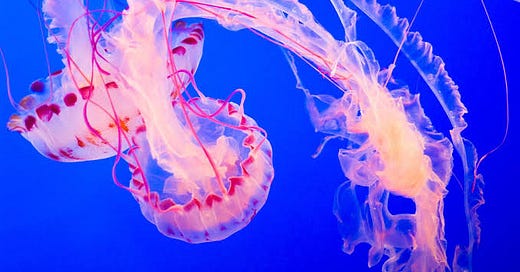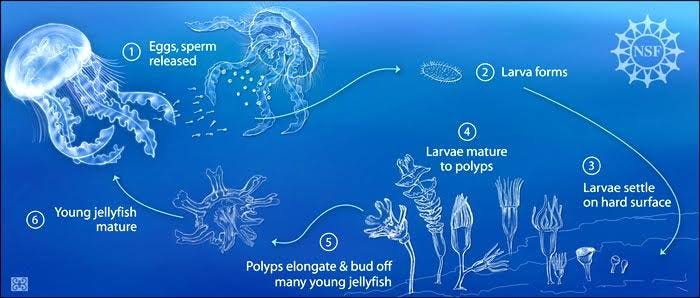BCOA Ep 4: Jellyfish
And there are ˹countless˺ signs on earth for those with sure faith (Q51:20)
Assalamu alaykum wa rahmatullahi wa barakatuhu🤍.
Jellyfishes are fascinating, elegant, and mysterious to watch in the water — I had a weird hobby of watching videos of them in the water on yt, they’re just so pretty and fascinating to watch.
Jellyfishes don’t have a heart, blood, or even a brain. They don’t have bones or lungs/gills either.
So how does a jellyfish live without these vital organs?
Their skin is so thin that they can absorb oxygen right through it, so they don’t need lungs/gills. They don’t have any blood so they don’t need a heart to pump it. And they respond to the changes in their environment around them using signals from a nerve net just below their epidermis - the outer layer of skin - that is sensitive to touch, so they don’t need a brain to process complex thoughts.
Imagine if you could just split in half and create a second version of yourself?😃
If you cut a jellyfish in half, the pieces of the jellyfish can regenerate and turn into two new jellies. —SubhanAllah 😃.
Some jellyfishes have super long tentacles
The lion’s mane jellyfish is the world’s largest jellyfish species. It can have tentacles that are over 27 meters long - longer than the size of the blue whale which is the biggest mammal in the world! — wow 😮.
Most live for only a few weeks, but some are known to survive a year or longer.
Jellyfishes are between 85% and 98% water. If they wash up on land, they’ll almost disappear as their water evaporates.
The adults are either male or female, but in some species they change their sex as they age.
The immortal Jellyfish
The Turritopsis dohrnii, popularly known as the immortal jellyfish is a species of jellyfish about 4.5 millimetres wide and tall (likely making it smaller than the nail on your little finger 😮), that can actually reverse its life cycle.
When the medusa (adult jellyfish) of this species is physically damaged or experiences stresses such as starvation, instead of dying it shrinks in on itself, reabsorbing its tentacles and losing the ability to swim. It then settles on the seafloor as a blob-like cyst. — amazing 🤯.
Over the next 24-36 hrs, this blob develops into a new polyp - the jellyfish's previous life stage - and after maturing, medusa bud off. This phenomenon has been likened to that of a butterfly which, instead of dying, would be able to transform back into a caterpillar and then metamorphose into an adult butterfly once again.
The process behind the jellyfish's remarkable transformation is called transdifferentiation and is extremely rare. It’s only known to occur in this type of jellyfish.
This life cycle reversal can be repeated, and in perfect conditions, it may be that these jellyfish would never die of old age.
Can immortal jellyfish die?
An immortal jellyfish may bend the rules to rejuvenate itself, but it can't always cheat death. For example, jellyfish, including immortal ones, are prey to other animals, such as fish and turtles.
How and what do jellyfishes eat?
They feed on planktons, crustaceans and plants— when they’re young.
They trap their prey within their stingers. These stingers will then paralyze their prey.
The jellyfish will then swallow the their prey whole, absorbing nutrients such as protein and omega acids as it digests.
Allāh created every creature in such a unique way. Not only are these creatures pretty to look at, they were created in such a fascinating manner with amazing characteristics. Say ALLĀHU AKBAR, for truly Allah (SWT) is the GREATEST!
Ghafir - 40:81
وَيُرِيكُمۡ ءَايَٰتِهِۦ فَأَىَّ ءَايَٰتِ ٱللَّهِ تُنكِرُونَ
And He shows you His signs. So which of the signs of Allah do you deny?





